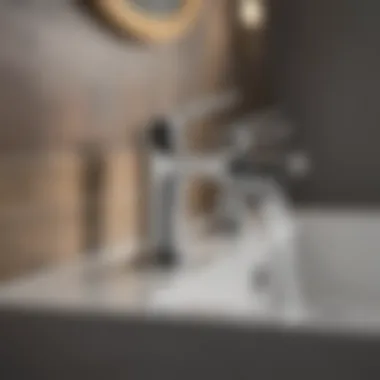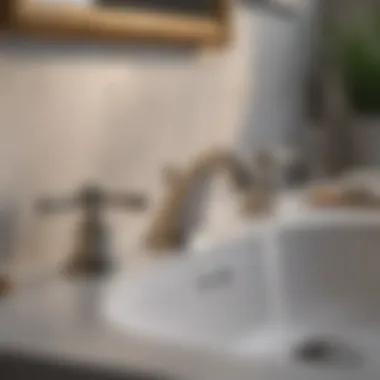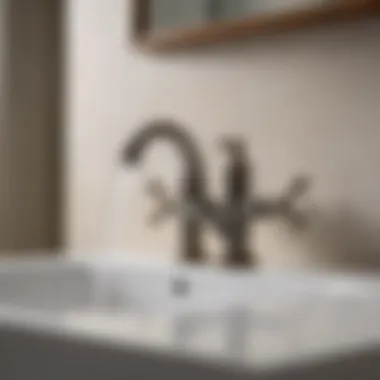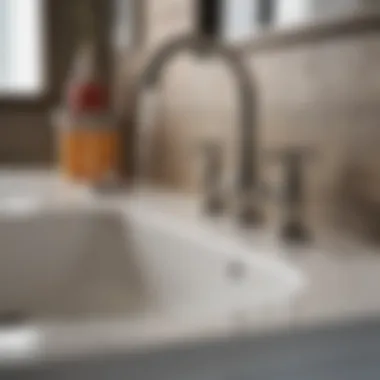Mastering the Art of Two-Handle Bathroom Sink Faucets


Intro
When considering the functionality and aesthetics of a bathroom, faucets play a paramount role. Two-handle bathroom sink faucets are a favorable choice for many homeowners due to their traditional appeal and ergonomic functionality. Understanding how to properly select and instally these setups can drastically improve both the user experience and the overall design of your space.
In this guide, you will learn specifically about installation, maintenance and troubleshooting of two-handle faucets. Our goal is to help you ease into this DIY project confidently and efficiently.
Materials:
To embark on installing a two-handle bathroom sink faucet, gathering the appropriate materials is essential. Below is a detailed list:
- Faucet Set: Ensure it is a two-handle model suitable for your sink.
- Water Supply Lines: Usually made of stainless steel.
- Teflon Tape: For sealing water connections.
- Plumber’s Putty: To create watertight seals around the faucet base.
- Screws and Washers: These are typically included with the faucet set.
- Cleaning Supplies: Cloth and sponges ensure cleanliness before installation.
- Optional - Anti-slip Mat: Useful to improve grip when working in sometimes slippery workspaces.
- Measurements: Typical sizes include a standard 8-inch spread, but measure your sink to confirm.
- Measurement: Roughly 16 inches each.
Tools:
Before starting the installation process, making sure you have the right set of tools is very important. Here is a curated list:
- Adjustable Wrench
- Pipe Wrench
- Screwdriver (Flat and Phillips)
- Pliers
- Pipe Cutter (if needed)
- Flashlight - useful in dark areas under the sink.
- Bucket to catch any water draining from old pipes or connections.
DIY Steps:
Follow these well-defined steps para salir adelante with installing your two-handle bathroom sink faucet:
- Turn Off Water Supply: Shut off the valves located under the sink to avoid any accidents.
- Remove the Old Faucet: Disconnect the supply lines and remove screws securing the old faucet.
- Prepare the Sink Surface: Clean the area where the new faucet will be installed. Pads of debris can compromise seals later.
- Position the New Faucet: Set the new faucet in place. Align it according to given instructions while watching your measurements.
- Secure the Faucet: Use screws and washers provided in your new faucet kit, ensuring tight placement.
- Connect Water Supply Lines: Attach the supply lines according to your meter tools. Tape as needed to prevent leaks.
- Seal with Plumber’s Putty: Apply plumber's putty around the base. This will protect from water ingress.
- Check Everything: Turn on the water supply again to check for leaks or any other issues. Test hot and cold functions separately.
- Final Inspection: If everything looks good, clean up the workspace.
Technical Aspects:
Refinements in technique can improve the quality of this installation significantly:
- Allow ample time—about 1 to 2 hours depending on experience level—to carry out this procedure at a comfortable pace.
- Ensure to work in layers, attending to one stage completely before moving on helps clarity.
Troubleshooting Tips:
As with many DIY processes, mistakes or misunderstandings can sometimes happen:
- If water is leaking from connections, turn off the water, ensure correct installation and tighten any fittings accordingly.
Ensure to dediate time and patience through the installation process. It ensures the quality and functionality of your new faucet.
Following through the above information helps enhance both your understanding and enjoyment of your upgraded bathroom space.
Intro to Two-Handle Bathroom Sink Faucets
The two-handle bathroom sink faucet remains a prevalent choice among consumers seeking both aesthetics and practicality. This faucet design offers several advantages that enhance user experience in the bathroom. By understanding the elements of a two-handle faucet, homeowners can make informed decisions, ensuring their purchases are aligned with their needs and preferences.
Definition and Overview
A two-handle bathroom sink faucet consists of two separate handles that regulate hot and cold water flow independently. This design allows for precise temperature control, offering users the ability to select their desired warmth or coolness with ease. Typically situated on either side of the spout, these handles integrate simplicity with effectiveness. Manufacturers often produce these faucets with a variety of materials, including brass, stainless steel, and plastics, ensuring durability and long lifespan.
With a range of styles and finishes available, a two-handle faucet can match any bathroom décor. Its charm often elevates both functionality and the overall visual appeal of the sink area. For homeowners considering a renovation, opting for this fixture can transform the look and feel of the restroom through both form and function.
Comparison with Single-Handle Faucets
When evaluating faucets, the distinction between two-handle and single-handle designs is significant. Single-handle faucets operate with one control mechanism, combining hot and cold water with a one-motion adjustment. While they can be effective for efficient and quick adjustments, two-handle faucets engage a different approach.
Some notable comparisons include:
- Control Precision: Two-handle faucets provide superior control over water temperature and flow. Users can fine-tune both aspects more effectively versus the sometimes ambiguous temperature control of single-handle faucets.
- Design Versatility: Aesthetically, two-handle faucets come in various designs. They can present a more traditional or sophisticated look. Single-handle options, by nature, sometimes commit to a contemporary or more minimalist style.
- Installation Requirement: Installing a two-handle faucet typically demands more plumbing work, as spacing must accommodate the additional handle. Conversely, a single-handle design’s installation may require less adaptation.


The choice ultimately boils down to personal preference, lifestyle, and the existing bathroom layout. Homeowners can weigh their options with guidance on functionality and design preference in mind.
Design Features of Two-Handle Faucets
Two-handle faucet design allows for distinct aesthetic choices and optimal functionality in the bathroom. Choosing the right design elements impacts both appearance and practical use. Understanding specific design features enables homeowners to select faucets that blend with their bathroom style while ensuring long-lasting performance.
Material Options
Brass
Brass is a favored material for two-handle faucets due to its durability and resistance to corrosion. This alloy often consists of copper and zinc. Its robust nature contributes to an undeniably long lifespan, making it suitable for bathroom environments where moisture is abundant. Another key characteristic of brass is its ability to maintain surface integrity, which nowdays homeowners acknowledge as a highly respectable option. One noteworthy feature is that brass can be easily molded into intricate designs, ensuring that homeowners enjoy both form and function. However, it can be pricey compared to alternatives, affecting budget considerations.
Stainless Steel
Stainless steel is known for its strength and modern aesthetic. This material houses properties that resist tarnishing and corrosion, making it ideal for many complex bathroom environments. The toghness is one important aspect that adds to its growing popularity among contemporary homeowners. Apart from the visual appeal, stainless steel's unique homogeneous surface assists in maintaining hygiene, a major factor for many households. The downside may be its slightly higher price point, although many find the investment justifiable due to its longevity and low-maintenance nature.
Plastic
Plastic faucets are recognized for being lightweight and affordable options. While these attributes make them serve as attractive choices for many homeowners, there are considerations regarding their long-term effectiveness. Plastic is resistant to rust, but its durability might not parallel that of metal. One distinctive feature lies in the various color options and designs available. Therefore, it’s essential to weigh its initial affordability against potential replacement costs over time, which can be higher if regular use decreases plastic integrity.
Finishes and Styles
Polished Chrome
Polished chrome boasts a reflective surface that lends an elegant look to any bathroom. This finish emits a contemporary feel, appealing to aesthetic interests of many homeowners. Additionally, it remains a popular choice due to its ease of cleaning and maintenance, resisting the buildup of water spots. However, the downside lies in its potential jewelry-like appearance which may lead to fingerprint visibility daily, sculpting decisions for those who prefer a constantly glowing environment.
Brushed Nickel
Brushed nickel features a muted, dull finish that prevents glare, promoting a subtle aesthetic appeal. Its quality makes it receptive to showing minimal fingerprints and watermarks, thereby maintaining cleanliness in high-traffic bathrooms. This finish does present a sophisticated look while adding to longevity. The main concern however, is possible incompatibility with certain decor styles that require shine or modern flair, which some homeowners may seek.
Oil-Rubbed Bronze
Oil-rubbed bronze creates a warm value in any bath decor. Its antique-style appeal matches classic and traditional spaces easily. The surface gives a hand-worked feel which can charm aesthetics effectively. One remarkable feature is that this finish develops character and dark natural patina over time. This quality might entice those who appreciate a vintage touch. On the flip side, obtaining a consistent look from this varies based on manufacturer, sometimes challenging standardization in large bathroom mix-and-match projects.
Handle Types and Ergonomics
Lever Handles
Lever handles stand out for their easy function. The unique lateral movement allows simple adjustments to hot and cold water. Control is often responsive and does not require and'ediel strength to operate. This characteristic makes them an excellent choice for individuals with mobility challenges. Conversely, sommm compromises on aesthetic offerings arise as many lever designs tend toward modernity, leaving traditionalists underwhelmed in their style options.
Cross Handles
Cross handles exhibit classic designs bringing an inviting warmth to traditional setups. Their distinctive crisscross shape enhances grip for drivers on hot and cold sides. Known for offering smooth rotation controls, they elevate the operator's experience favorably. On the contrast, such mechanical intricacies can limits the accessibility due to require higher turning strength, rendering it unsuitable for some functionality needs for wider homes perspective.
Selecting the Right Faucet
Selecting the right two-handle bathroom sink faucet is a crucial part of your bathroom renovation or upgrade. This decision impacts functionality, aesthetics, and even the longevity of the fixture. Understanding the specific needs of your bathroom and how a particular faucet complements these needs is essential for a successful choice.
Assessing Sink Compatibility
The first step in selecting a faucet is evaluating how well it fits with your existing sink. Most commonly, sinks will have either 4-inch or 8-inch center distances.
- 4-inch centerset: These configurations usually include the faucet and handles in a single unit. Ideal for smaller sinks, this design can create a clean and compact look.
- 8-inch widespread: A larger sink typically requires a more extended reach. This means the faucet and handles are installed separately, allowing for greater design flexibility.
Measuring the distance can be done using a simple measuring tape. It's also important to check the number of mounting holes that are drilled into your sink.
Water Pressure Considerations
Water pressure is another pivotal factor to consider. Faucets operate within specific ranges of pressure to function correctly. Low water pressure can lead to weak water flow, affecting user experience significantly. Here are things to bear in mind:
- Ensure your home’s water pressure is between 20 and 80 Psi for optimal faucet performance.
- Faucets with flow restrictors can help manage water consumption while maintaining good performance, enhancing efficiency.
Optimal water pressure is crucial for optimal operation.


If you notice irregular water pressure, it may advise you to look into plumbing issues more closely before the purchase.
Budgeting for Your Faucet
Budgeting is an important consideration when selecting a faucet. The price of two-handle faucets can vary greatly based on materials, design, and functionality. Before starting your shopping journey, establish a realistic budget. Here are a few to observe:
- Entry-level faucets: These tend to be made of less durable materials, typically ranging from $60 to $120.
- Mid-range faucets: More durable and stylish, these faucets usually fall in the range of $120 to $250.
- High-end models: Premium options with advanced features, such as touchless technology, may start around $250 and can exceed $500.
When you clarify your budget at the beginning, you can narrow down options systematically without overwhelming yourself with choices.
Installation Process for Two-Handle Faucets
The installation of two-handle faucets requires careful attention to detail. This part of the article provides practical insights that are beneficial for successful implementation. Installing a faucet correctly is vital for maintaining its Features and functions while ensuring water conservation. Moreover, understanding the installation process helps avoid future issues such as leaks or pressure problems, promoting the long-term usability of the fixture in your bathroom.
Tools Required
Before diving into the installation, it is essential to gather the appropriate tools. Having everything you need on hand streamlines the process and reduces disruptions. Below is a list of tools that are commonly required:
- Adjustable wrench
- Basin wrench
- Screwdriver (flathead and Phillips)
- Plumber's tape
- Bucket (to catch any water spillage)
Taking the time to prepare your workspace with these tools enhances efficiency. This preparation makes it easier to navigate the installation process without unnecessary interruptions.
Step-by-Step Installation Guide
Understanding each phase of the installation makes it easier for you to follow along and complete the task efficiently.
Shutting Off Water Supply
Shutting off the water supply is a critical first step in installing a new faucet. This not only prevents flooding but also ensures safety while you work. The main water valve is usually located under the sink.
- Key Characteristic: This essential action takes only a few moments but is crucial for protecting your home from potential water damage.
- Benefits: Without shutting the water off, even tiny mishaps could lead to a mess, requiring hefty cleanup.
- Consideration: It is unique because it minimizes risk while maximally preparing your workspace for the installation task.
Removing the Old Faucet
Once the water supply is off, you will need to remove the existing faucet. This may include draining any remaining water still in the lines. During this process, check for any signs of rust or corrosion on old components.
- Key Characteristic: Proper removal involves unscrewing connections carefully; twisting or forcing can damage fittings.
- Benefits: Getting rid of an old faucet opens the door for updates and higher efficiency. It also aligns with aesthetic improvements in your space.
- Consideration: Unique in that doing this step well ensures future repair is easier and prevents issues from any old components.
Installing the New Faucet
Installing the new faucet is often perceived as the most thrilling part of the installation process. This step entails attaching the new unit in accordance with the producer's guidelines.
- Key Characteristic: Take caution to not overtighten fittings; this could lead to cracks or warping.
- Benefits: A new faucet can drastically improve water consumption, aesthetic appeal, and functionality. You can choose modern finishes that complement your style.
- Consideration: Unique features in most modern faucets allow for easy adjustments that support enhanced user experience.
Connecting Water Supply Lines
Finally, but important, connecting the water supply lines reintegrates the faucet with your home's plumbing. This may involve using plumber’s tape on screw threads to ensure a snug fit.
The lines must be aligned correctly so that they form a seam protecting from leaks. Ensuring safe connections here impacts the entire system’s performance. Ultimately, a well-connected faucet equates to trouble-free daily use and satisfaction.
Remember, careful installation is critical not only for utility but also for enjoyment of your new faucet.
Maintenance of Two-Handle Faucets
Maintenance is a crucial component when discussing two-handle bathroom sink faucets. Regular maintenance ensuresthat your faucet works efficiently and lasts for years. Proper care can prevent minor issues from becoming larger problems, ultimately saving both time and money. As with any plumbing fixture, neglect may lead to leaks or functionality concerns. It's not just about aesthetics—well-maintained faucets contribute to an enhanced bathroom experience.
Regular Cleaning Tips
Maintaining a clean faucet plays a significant part in both its longevity and appearance. Begin by wiping the faucet periodically with a soft cloth. For achieving a polished surface without scratches, avoid harsh chemicals. Instead, consider using a mixture of vinegar and water. This simple blend can effectively remove mineral deposits and soap scum without damaging the finish. Remember to focus on both the spout and handles for a comprehensive clean.
Moreover, it’s key to check the aerator at the faucet's end. Cleaning or replacing clogged aerators can solve low water flow issues. Depending on water hardness, a cleaning regimen every few months may be ideal. This keeps water flowing freely and the sink looking good.


Identifying Signs of Wear
Paying attention to small changes can significantly benefit the lifespan of your faucet. Many times, subtle indicators can signal that something is amiss. This awareness can save you a hassle later on. Trust your instincts on functionality or appearance changes; they may not be trivial. Two essential areas that require attention are leaking handles and corroded components.
Leaking Handles
Leaking handles can signal particular types of wear in two-handle faucets. These leaks generally stem from worn washers or seals within the handles. Water seeping from handles not only wastes water but can also lead to larger plumbing issues. Ignoring this situation may cause damage to countertops or cabinetry. Addressing leaking handles early may be a more cost-effective move rather than waiting for a bigger repair.
One beneficial aspect of catching this issue is the ease of fix, often simply requiring a washer replacement.
Corroded Components
Corroded components often surface as an unseen problem in taps. They can result from too much exposure to water and other elements. Such corrosion can degrade both function and appearance. When faucets age, it’s normal for some metal parts to corrode over time. Key signs to watch for include rust forming on visible metal areas, which may lead to leaks or weaken the faucet assembly.
Considering the potential for replacement will help reinforce why frequent checks for corrosion are valuable. Swift action can halt corrosion paths before those lead to larger malfunctions or complete replacements of the faucet. Regular maintenance is worthwhile not just for preserving appearance—multiple benefits exist by implementing a cleaning routine and catching issues early.
Common Problems and Troubleshooting
Common problems and troubleshooting are essential aspects of maintaining the functionality of two-handle bathroom sink faucets. Understanding these issues enables homeowners, plumbers, and DIY enthusiasts to address minor inconveniences before they escalate into more significant concerns. Reactive measures can save time and expenses associated with the repair of plumbing systems. A proactive approach can also extend the lifespan of your faucet. Therefore, encompassing troubleshooting methods in this guide seriously assists users in maximizing their faucet's endurance.
Low Water Pressure Issues
Low water pressure can diminish the effectiveness of your faucet significantly. Several reasons may contribute to this problem. It might arise from clogged aerators, deteriorated water supply lines, or problems with the municipal water supply. Regular maintenance makes it easier to avoid or identify low water pressure issues directly.
To check for low pressure:
- Turn on the faucet at maximum flow.
- Observe if the water runs slower than usual.
If there's a sign of such, dismantle the aerator. It commonly harbors debris causing blockages. Cleaning the aerator is often quite manageable and can restore normal pressure.
Moreover, review water supply lines for any burst or kinked pipes resulting in pressure drops. If low water flow persists after evaluating these elements, consider consulting a professional to detect deeper issues.
Leaking Faucets
Leaking faucets are frequently prominent and frustrating problems. Water drips not only cause wasted resources but also can lead to increased bills. Leaking might result from worn-out washers, o-rings, or seats that need replacement.
Identifying leaks is essential:
- Check beneath the sink for water pooling.
- Assess handles for any dripping.
Next, remedying those leaks often involves simply replacing worn parts. Maintenance can significantly improve your faucet’s performance. Don’t overlook the significance of these replacements; dealing with leaks promptly prevents extensive countertop or cabinet water damage.
Handle Operation Problems
Issues with handle operation can range from stiffness to being entirely stuck. Sticky handles can make usage cumbersome. This problem might stem from mineral build-up or worn components. If the coolant and flow function remains steady while others interfere, then handle mechanisms could be the concern.
Fixing or easing operation may include:
- Dismantling the handles to inspect for signs of corrosion.
- Cleaning operational parts or using lubricants specifically designed for faucets.
Ultimately, ensuring smooth operation not only enhances user experience but maintains plumbing integrity.
Overall, attention to common problems helps in maintaining the efficiency and aesthetic appeal of two-handle bathroom sink faucets.
The End and Final Recommendations
In this article, we have explored the multifaceted aspects of two-handle bathroom sink faucets. The conclusion presents a crucial opportunity to consolidate the knowledge gathered throughout. Understanding these units not only assists in effective installation but also enhances the appreciation of their functionality and utility. A proper grasp of the important features, such as materials, finishes, and configurations, leads to more informed purchase decisions.
Summary of Key Points
- Design Features: Two-handle faucets come in various materials, including brass and stainless steel. Each material has its unique advantages regarding durability and aesthetics. Various finishes also allow individuals to customize appearance according to bathroom decor.
- Installations Steps: Following a structured installation process can significantly reduce issues later. Carefully shutting off water supply and accurately connecting water lines promotes long-term functionality. It prevents leaks and helps maintain pressure.
- Maintenance and Troubleshooting: Regular cleaning and recognizing signs of wear constitute essential aspects of faucet management. From identifying leaks to handle issues, preparedness here could save unexpected repair costs.
- Common Problems: By being aware of frequent faucet challenges, you can quickly address future concerns. Simple problems, such as low water pressure, can sometimes lead to elaborate fixes if overlooked.
Future Considerations
When planning for a faucet upgrade, anticipate future needs. As home styles and owners may evolve, consider selecting a model that aligns with changing bathroom aesthetics.
- Water-Saving Technologies: Take note that innovations such as low-flow faucets can significantly assist in resource conservation. Investing in the right faucet delivers ergonomic benefits and environmental sustainability.
- Technological Integration: Whether it be touchless faucets or smart control functions, understanding evolving technology may shape your choices. Reviewing consumer feedback and technological advancements can guide you through models featuring greater efficiency or unique designs.
- Longevity and Warranties: Finally, emphasize considering products with on-going warranties. This provides peace of mind. Understand that warranties collaborate to relieve consumers from potential full pay for repairs or replace depending on product longevity.
Integrating these insights emphasizes that the efforts made with two-handle faucets go beyond mere installation. The potentials for durability and aesthetic enhancement contribute significantly to the value of living spaces.







